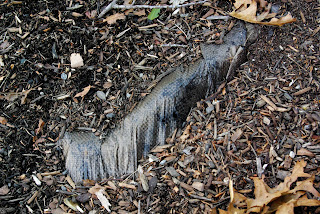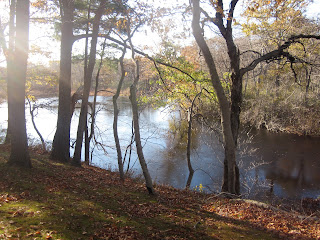This past October my husband and I realized a dream of buying a riverfront home. Our little 0.30 acres (see right) of Ipswich, MA sits alongside the often lazy
Ipswich River, which meanders its way from its headwaters in Burlington and Wilmington, MA all the way to the Atlantic Ocean, spilling out its flow just north of Crane Beach into the Plum Island Estuary (PIE). PIE drains a 600 square kilometer area and is part of the larger Great Marsh, the largest continuous salt marsh in New England.
A very large part of this estuary is protected by the
Parker River National Wildlife Refuge and local land trust. But that can't protect everything that goes into the rivers and streams that feed the wildlife refuge and salt marshes (i.e fertilizers, pesticides, and petroleum runoff). Parker River NWR announced this spring a grant program to "give impetus and incentive to property owners within the Plum Island Sound watershed to implement organic green landscaping projects in order to improve water quality and quantity of the Plum Island Estuary." They dubbed the grant "
Slow the Flow".
The Ipswich River Watershed Association posted info about this grant a week before my husband and I were to appear before the Ipswich Conservation Commission to present an application to remove the old yew shrubs, relandscape with natives, and more importantly remove the 2500 square feet of plastic sheeting that I discovered the former owner's landscaper had laid down years before under about six inches of mulch to prevent weeds. It's now poking out in many places ( see left).
Being right next to the river and having plastic cover most of your yard is not a good thing. We want the watershed to hold onto runoff, not have it all dump into the river and go out to sea. Large paved surfaces in more developed towns upstream are adding to the
major flooding Ipswich has experienced in recent years. The sooner I could rip out that impervious plastic the better I would feel about myself and our owning this property.
The Conservation Commission easily granted us permission for the shrub removal, addition of a native wildlife garden (where there is otherwise just bare mulch), a vegetable garden, shrinking the lawn and installing a safety fence in a small area of the backyard so my two very young children didn't end up in the river. The next day I immediately started digging. If you can imagine my goal of native cottage and woodland gardens, with colorful perennials and ferns, and you look below to see what I had to start with you can see why I started digging right away. My vision is pretty much the antithesis of this picture.

Even with Conservation's approval in hand I thought it would be a long shot to get this grant. It could mean a matching award towards all the ferns, jack-in-the-pulpits, foam flowers, cardinal flowers, fothergillas and blueberries I had been dreaming about all winter. In the four months we had owned the house we had spent a lot of money on insulation (it had almost none) and other energy upgrades which were a priority, not leaving much in my dream garden budget. The grant would allow more of all these plants and larger specimens too. Instead of planting over four or five years I could afford to fill in the bare areas this year. I attended the workshop in March, listened to many great lectures on research going on in PIE that I wasn't aware about, and native gardening tips that I were aware about but was happy to hear again. I sent my application in on April 18th and crossed my fingers.

In the meantime my husband ripped out all the yews (as much as I despise destroying any plant, I couldn't find a home for the yews and they sadly ended up at the local leaf dump). For a few weeks it looked like a tornado hit the house. I made many promises to neighbors that "it will look better some day, I promise!" As the new green color went on the clapboard, the doors were redressed in a bright blue and the stucco lightened I think the neighbors began to believe me. And while awaiting word on the Slow the Flow grant I kept busy filling in the otherwise empty and desert-like strip of mulch along the road (foreground to the left), and the now-empty space by the front door, with blanket flowers, liatris, black eyed susans, columbines, coneflowers, ferns, and day lilies I started in my greenhouse - and a pussy willow my three-year-old picked out at a local nursery.

On rainy days my girls helped me make mosaic bird baths that are to become focal points in each of the garden areas. Although I keep finding their plastic toy lizards in them, they're also very good at making sure the bird baths are supplied with water from the two rainbarrels I just installed. I have had eleven neighbors stop to tell me just this week that "WOW, what a difference!" or ask "May I come back and write down what these plants are?"
And then I came home last Thursday night to an email stating I got the grant! I could not have been more thrilled. Some women indulge themselves buying shoes, or jewelery or clothes.
I buy plants. You can never have too many books or flowers I always say. So this weekend's plan is to hit the local nurseries and next week's plan is a trip with my older daughter to
Garden in the Woods, home of the New England Wildflower Society and the mecca of native woodland plants.
A big thank you to the team at Parker River NWR for awarding me this grant and beginning what I know is going to be a rewarding and beautiful journey for our family and our new home. I will post pics every week on my progress and look forward to sharing the results.
 A big part of our landscaping plan involves shrinking the lawn. I've estimated our final goal to be about 260 fewer square feet of lawn. Which doesn't seem like much, but that's about the entire footprint of the lawn of our old property in downtown Ipswich. Our new 1400 square feet of lawn is far more than we need, our two kids under the age of four spend most of their outdoor time digging in the mud, not playing on the lawn.
A big part of our landscaping plan involves shrinking the lawn. I've estimated our final goal to be about 260 fewer square feet of lawn. Which doesn't seem like much, but that's about the entire footprint of the lawn of our old property in downtown Ipswich. Our new 1400 square feet of lawn is far more than we need, our two kids under the age of four spend most of their outdoor time digging in the mud, not playing on the lawn. 














